|
Galena welcomes the return of Dr. Gubanich and his superb birding workshops! Al will be providing regular discussions & workshops on birding on the 3rd Saturday at 10 am each month into summer 2022. Here below are the dates -- come join us as we explore birding with one of Nevada's most accomplished ornithologists!
DECEMBER 11 Waterbird of Nevada JANUARY 22 Waterfowl of Northern Nevada FEBRUARY 19 LBJs (Little Brown Jobs) of the Bird World MARCH 19 Breeding Birds of Galena Forest APRIL 16 Birding by Ear MAY 21 What makes a Bird a Bird? JULY 23 Hawks!
1 Comment
2/17/2021 0 Comments All About Avalanches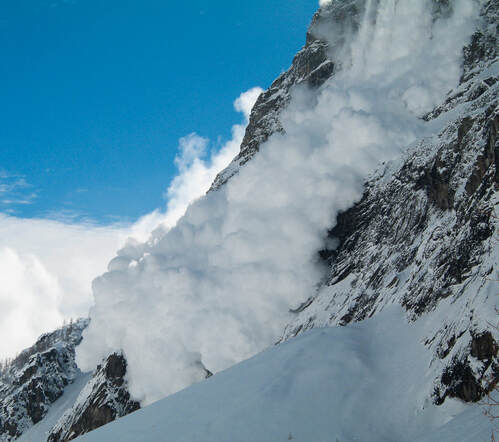 Every winter, there are instances of people getting trapped in avalanches. This is an unfortunate and devastating part of outdoor winter recreation. An avalanche is a mass of snow that slides rapidly down a slope, usually a steep mountain side. Avalanches can be triggered by weather, such as drastic changes in temperature or wind-drifting snow, or by human activities, such as stress from skiers. Most avalanches occur in the backcountry, where the snow isn’t meticulously managed. In and around ski resorts, avalanche experts often create avalanches in strategic spots to prevent natural avalanches from damaging property or hurting patrons. Almost all avalanches occur on slopes between 25 and 50 degrees, above treeline, and facing away from prevailing winds. This side of the slope tends to collect a lot of snow. Between 20 and 40 people die each year in North America due to avalanches; 90% of these deaths are from slides caused by the victims or their parties. Fortunately, there are many things you can do to reduce risk.
2/8/2021 3 Comments All About Snowflakes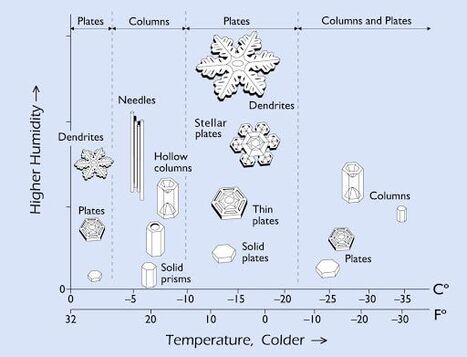 Snowflakes are clusters of ice crystals that form around a piece of dust or sediment. You’ve probably heard that all snowflakes are unique and no two snowflakes are identical, and it’s true! Wilson Bentley was a meteorologist and photographer in the late 1800s and early 1900s who documented thousands of snowflakes with his camera. He never observed two snowflakes that were identical. There are several different types of snowflakes that form at different temperatures and humidity levels. The snowflakes we generally think of are dendrites, which have six sides and often have elaborate designs and details. These form at moderate temperatures (-5-15oF) and high humidity. There are several other types of snowflakes that are less elaborate, visible in this chart. 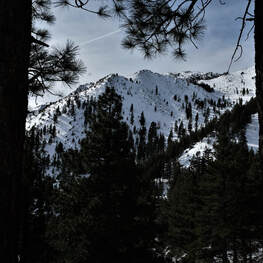 In Reno, we get snow every year. The amount of snow and timing fluctuates significantly from year to year, but we wait for it and expect it regardless. Snow consists of ice crystals that form in clouds high in the sky. They then fall to the ground and accumulate into a layer of snow. Clouds are made of water vapor, which is water in its gaseous form. When the atmosphere where the clouds are gets too cold the water vapor condenses directly into ice, skipping the liquid water phase, and falling to the ground as snow. Snow is considered a mineral because it’s a naturally occurring inorganic, homogeneous solid. 11/25/2020 3 Comments Wild Turkeys in Nevada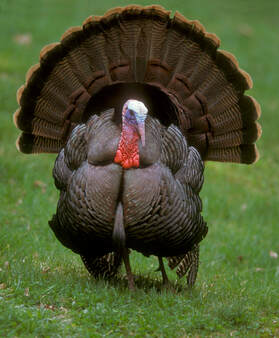 Wild Turkey, PC: Riki7 via Wikipedia Commons Wild Turkey, PC: Riki7 via Wikipedia Commons Turkeys are one of the most recognizable birds in the United States, but many people don’t imagine them in the wild. However, wild turkeys are found in all 50 states, including the Silver State, Nevada. There is one species of wild turkey in the United States, Meleagris gallopavo, but it’s split into six different subspecies. In Nevada, we have the Rio Grande wild turkey and the Merriam’s wild turkey, two subspecies adapted to drier, warmer climates. Most of the population here is made of Rio Grande wild turkeys, a large turkey with longer legs suited to prairie ecosystems. They live in groups in shrubby, grassy areas adjacent to streams. The Nevada Department of Wildlife began introducing turkeys in the state in 1960, in areas like the Ruby Mountains, river corridors in western Nevada, and Lincoln County and the Moapa Valley in southern Nevada. Because their numbers and range is quite small, any problems like drought or predation can seriously affect populations of turkeys in Nevada. However, the population is able to support a hunting season almost every year, closely managed by NDOW to ensure a viable reproductive population is maintained. Learn More about Turkey Hunting in Nevada Learn More about the different Turkey Subspecies Download a Turkey Coloring Page 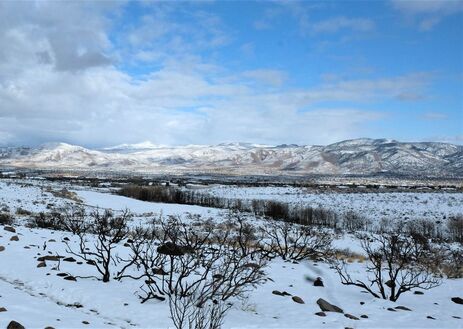 Riparian ecosystems are the plant and animal communities surrounding rivers and other bodies of freshwater. Particularly in the arid west, these ecosystems are extremely important for providing food, shelter, and water to a variety of wildlife. Riparian areas are usually more diverse and productive than their drier, upland counterparts. Plants in riparian areas often grow quickly and spread rapidly, and the water present provides habitat for aquatic ecosystems to form. When it comes to wildfires, the high moisture levels of the plants in this ecosystem can provide a buffer, stopping or slowing the spread of a wildfire. They can also provide refuge for animals fleeing fire. However, the presence of dense foliage in these areas can cause their own demise during drought years with high severity fires. If these plants experience a significant drought and there is a lot of standing dead (also literally called “fuel” in wildfire jargon), a wildfire can destroy an entire riparian ecosystem. Many riparian plants, like willows and aspens, are not adapted to survive wildfire and will die in a high intensity fire. This leaves the waterway vulnerable to erosion, excess sun, and sedimentation, damaging the aquatic ecosystem within it. Fortunately, riparian ecosystems can be very resilient and grow back quickly. Plants like aspens and willows can resprout through roots that often survive wildfire, restabilizing the soil quickly and beginning to form a canopy cover. Grasses and forbs often respond well to wildfire, sprouting quickly and forming important ground cover and forage for wildlife. A section of Thomas Creek, in the northern part of Galena Creek Regional Park, burned this season in the Rock Farm Fire, killing many of the aspens, willows, and alders. We will be monitoring the establishment and regrowth of these species in the coming years and documenting the restoration of this area. 11/11/2020 1 Comment Black Bear Hibernation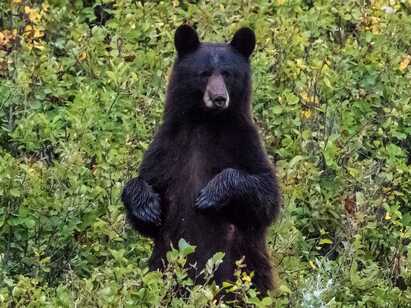 Black bears live throughout the Reno-Lake Tahoe area. They spend their summers foraging for bugs, fruit, roots, fish, and small animals. In the fall, as it gets colder, and their food sources begin to disappear, they have to enter a form of long-term deep sleep called hibernation. This process starts much earlier than when they actually go into a den and go to sleep. As temperatures begin to drop and days shorten in early fall, bears go into a state of hyperphagia. “Hyper” means a lot or excessive and “phagia” means to eat. Bears have to fatten up to store enough fat and energy in their bodies to get through the winter. In the Tahoe area the Kokanee salmon runs in fall help immensely with this process, providing a lot of fat and protein. During this period, bears often forage and eat for 20 hours a day! One of the main indicators for birds to enter hibernation is a lack of food, so please don’t provide food for bears; bear-proof your home and trash cans. Bears in the Reno-Tahoe area often begin hibernating around Thanksgiving but this varies based on weather. Since this year has been warm, they may enter hibernation later. When the time comes, they go into their dens and often don’t come out for several months! Adult females often produce cubs during this period if conditions are good. We’ll be saying goodbye to our bear friends soon, and will await their return in the spring. 11/5/2020 3 Comments Animal Migrations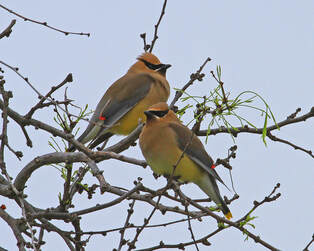 Cedar Waxwings can be found year-round, but primarily live here in the winter where they eat berries. Look for small flocks (20-40 birds) and listen for a soft whistle or buzz. Cedar Waxwings can be found year-round, but primarily live here in the winter where they eat berries. Look for small flocks (20-40 birds) and listen for a soft whistle or buzz. Fall is almost upon us! This means that many animals will be migrating to their winter grounds. But why do some animals migrate? Animals migrate in search of lands more suitable to their survival. This generally means warmer regions and higher food availability, though some animals also migrate for breeding purposes - such as salmon who migrate up rivers to escape ocean predators that might prey on their eggs - while others migrate in order to follow the rains - such as many animals in the African Savannah seeking to escape the seasonal drought. Naturally, the change in seasons causes these locations to move throughout the year. In the fall, animals usually migrate south to escape the freezing temperatures that winter brings; while in the spring, animals move north to follow their food sources and escape the summer heat. How do animals know where to go? Although it is poorly understood, animals use the magnetic field of the Earth in order to orient themselves North and South. Because the core of the Earth is made of metal (mostly iron) and also spinning extremely quickly, a magnetic field is created between the North and South Poles. Even though humans can’t see this magnetic field (which is what a compass is for), many animals are able to sense it. You could say that they have a sixth sense! Despite this, we still don’t understand how animals actually know that their destination will be better suited for them- yet paradoxically, they do it successfully every single year. Tule Lake in Northern California is one nearby area that boasts a massive bird migration every fall and spring. Almost 500 different species of birds can be spotted at Tule Lake, many of them stopping over for some rest and relaxation during their colossal journey from their summer grounds in Alaska and Canada to their winter grounds in southern California and Mexico. Throughout the fall, keep an eye out in the sky for flocks of birds migrating south! Can you identify what species of bird they are? 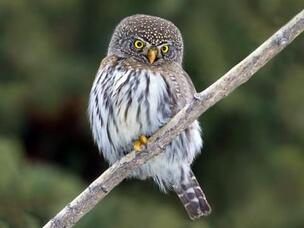 The Northern Pygmy Owl is one of the smallest owls in the US, and has been spotted at Galena Creek Regional Park! Photo: All About Birds The Northern Pygmy Owl is one of the smallest owls in the US, and has been spotted at Galena Creek Regional Park! Photo: All About Birds Owls are fierce predators and unique in the bird world for several reasons. 1. The first and most obvious adaptation is that they are nocturnal, although this isn’t always true. Most owls are active in catching and eating prey at night but many are still awake during the day. Some owls, like the Northern Pygmy Owl and the Burrowing Owl, are primarily active during the day. 2. They have fringed flight feathers that muffle sound and allow them to fly almost silently. This helps them sneak up and surprise prey. This adaptation is complemented by their strong talons, which help them hold on to large prey. 3. Another well-known adaptation is their flexible head; owls can turn their heads up to 270° to track their prey by sight and sound. 4. Finally, owls are similar to other predators in that their eyes are placed at the front of their head (as opposed to the sides like most songbirds and prey animals); this adaptation improves their depth perception, helping them track and catch prey. Prey animals have eyes on the sides of their heads because that increases their field of vision, allowing them to see predators and other threats. What other owl adaptations can you think of? More Information: Owl Research Institute 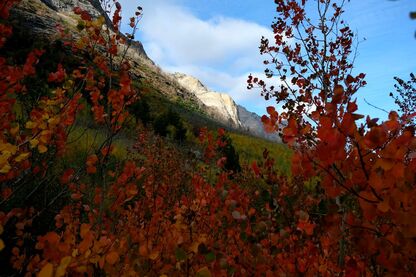 The Aspens in the Ruby Mountains in Eastern Nevada have already taken on various shades of yellow, orange, and red! The Aspens in the Ruby Mountains in Eastern Nevada have already taken on various shades of yellow, orange, and red! We’re answering the age old question today: why do leaves turn orange, yellow, and red in the fall? Most people know that it has something to do with chlorophyll and seems to correspond with trees losing their leaves for winter. And all those things are true, but let’s break down the whole process. Leaves have chlorophyll, a green-blue pigment; that’s what makes leaves green and that’s what allows plants to photosynthesize. But leaves also contain lots of other pigments, like keratinoids (orange/brown) and xanthophylls (blue/purple/red). The relative proportions of these other pigments determines how leaves change color in the fall. Some species (and even some individuals or populations of a given species) have high concentrations of carotenoids, and in the fall they turn yellow or orange and then brown and fall off. Other species (or individuals) have higher concentrations of xanthophylls and turn that brilliant red or even purple. Aspens are a great example of the chemical variation between individuals and populations. The aspens in Galena Creek turn a fiery orange in autumn; aspens in other areas turn yellow, and other populations even turn red! The nutritional composition of the soil and the specific genetics of a population will determine autumn colors. So, take your friends out to Galena Creek in mid-October to see the beautiful aspens, and make sure you drop the word “xanthophyll” in conversation! |
AuthorThis blog is managed by the staff and volunteers of Galena Creek Visitor Center. We write about parts of the natural world that we find fascinating and want to teach others about, as well as keeping you updated on the Visitor Center and park. If you want to learn more, please sign up for our monthly newsletter, where we share upcoming events, updates on the ecology of the park, and highlights from each month. Archives
October 2021
Categories |
 RSS Feed
RSS Feed
